Philips 7W LED Dixy Bulb
Philips 7W LED lamps priced at 99 rubles were sold in Dixie stores across the country. I test a lot of LED lamps, but in order to buy them you need to go somewhere or order them online, and they will buy this light bulb along with the products in the stores, so it’s very important that it is good and safe, especially that all previous LED lamps sold in chain stores "at home" could hardly be called good.
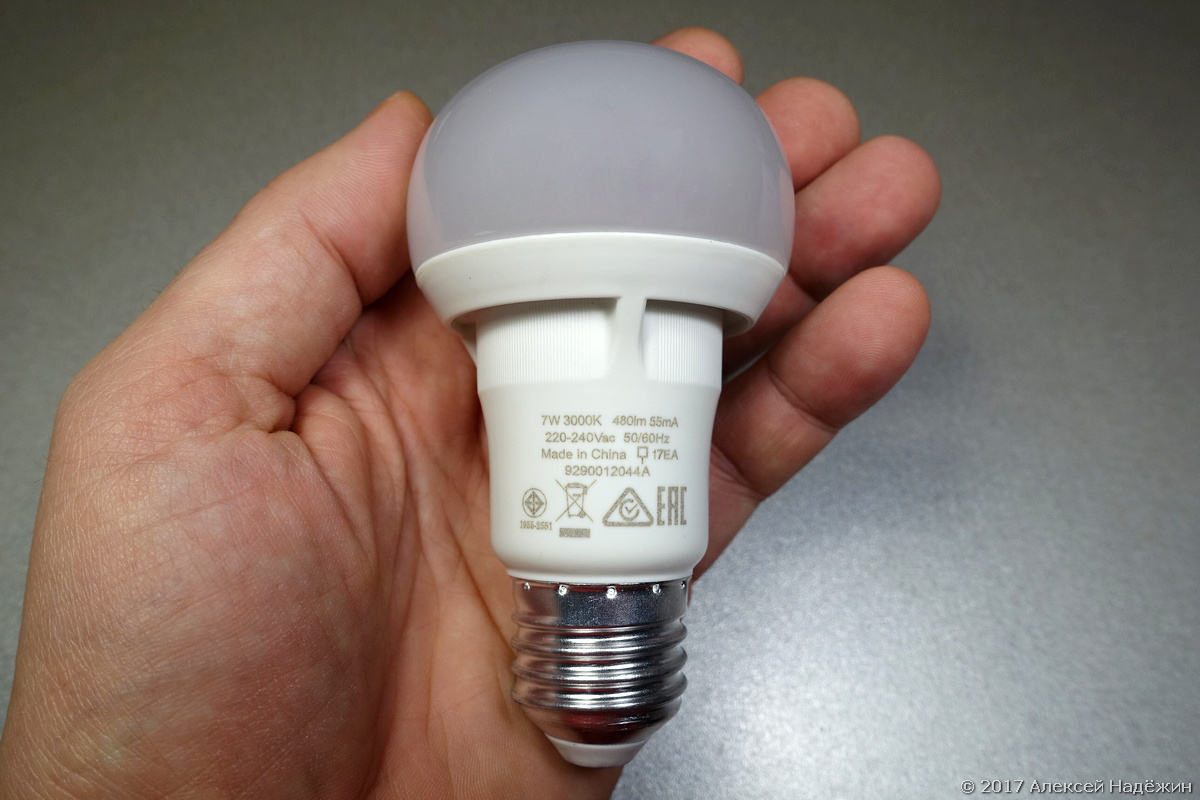
I went to the nearest store and bought a lamp with a warm light there.
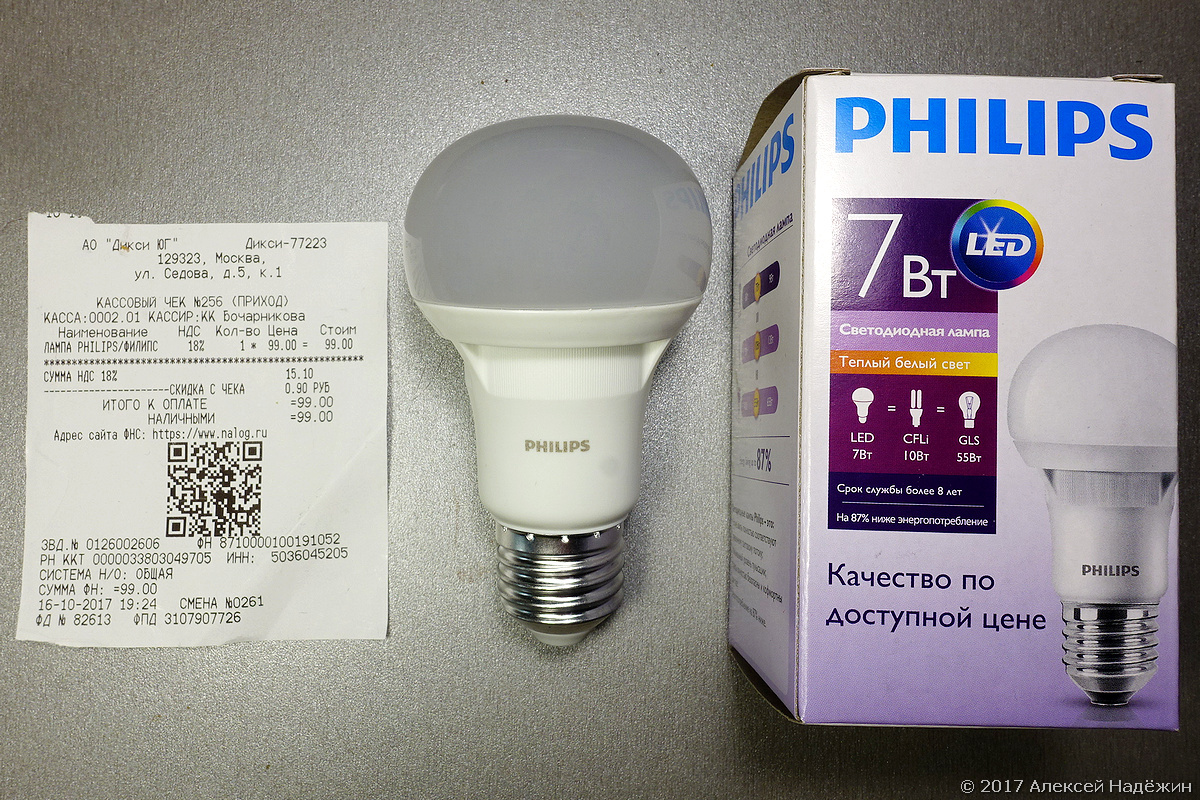
The manufacturer lists the following parameters on the packaging:
Power: 7 W;
Operating voltage: 220-240 V;
Light stream: 480 lm;
Replaces the incandescent lamp 55 watts.
Service life more than 8 years
Warranty period 2 years.
There is no exact color temperature, color rendering index, or service life on the package.
It is stated that “the lamps fully comply with the declared luminous flux. The minimum level of pulsation. Lamps are completely safe and comfortable for the eyes. "
Check it out.
The luminous flux of the lamp was measured with a Viso Light Spion instrument, the power consumption of a Robiton PM-2 instrument, a color rendering index, color temperature and ripple with a Uprtek MK350D instrument . Before testing, the lamp warmed up for an hour.

The measured luminous flux (464 lm) turned out to be lower than the declared by only 3% - this is within the limits of the measurement error.
Power consumption is even less than the stated - only 5.35 watts. Color temperature about 3100K. This kind of light is whiter than that of incandescent bulbs, but quite comfortable and much "warmer" than the light of 4000K white light bulbs. The pulsation of light is completely absent. The color rendering index is 83.3 and this is good (it is considered that CRI should be more than 80 for residential premises). Surprisingly, on the manufacturer's website for this lamp the color rendition index is declared 70. For the first time I come across the fact that the manufacturer declares the parameters worse than they really are. Perhaps the site is just a typo.
Although the box has a range of operating voltages of 220-240 volts, the lamp operates when the supply voltage drops to 98 volts, while the luminous flux is at least 90% of the nominal.
The packaging indicates (although very small print on the sticker) that the lamp cannot be used with dimmers and switches with indicators.

I checked the operation of the lamp with a switch having an indicator. When the switch is off, the lamp glows weakly and evenly. Most likely it will not damage the lamp in any way and it can be used with such a switch in the night light mode, which consumes almost no energy.
The measurement results of the Viso Light Spion instrument (in the table I give the measurement results with more accurate instruments, so the values of voltage, power, color temperature and color rendering index are slightly different).
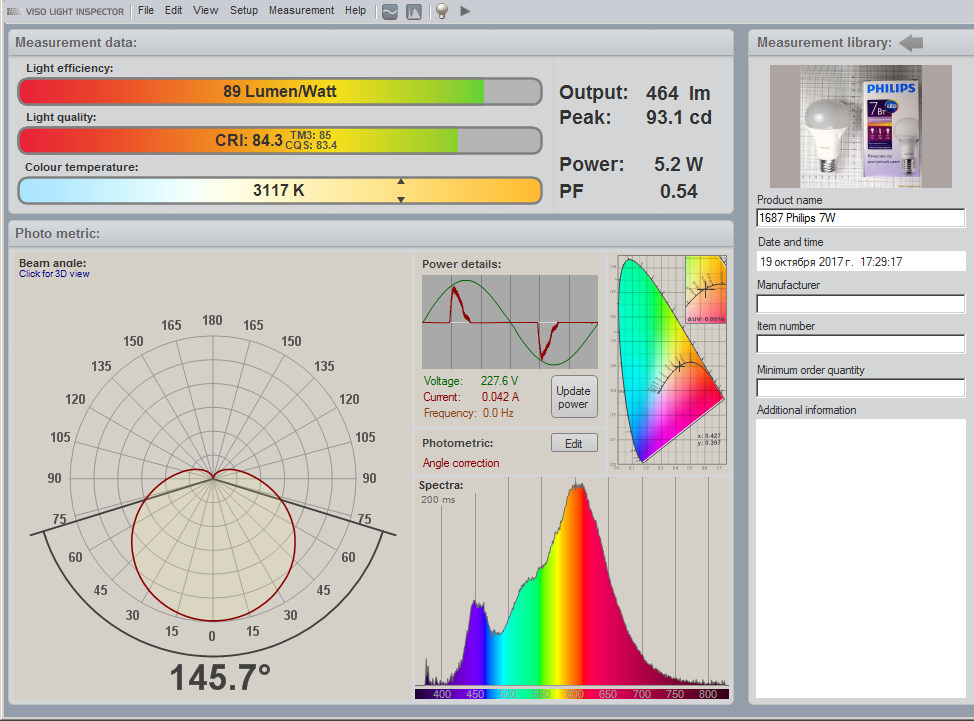
This lamp, despite the low price, really gives high-quality, comfortable and safe light.
During operation, the lamp does not heat up much - the maximum body temperature is 49 degrees.
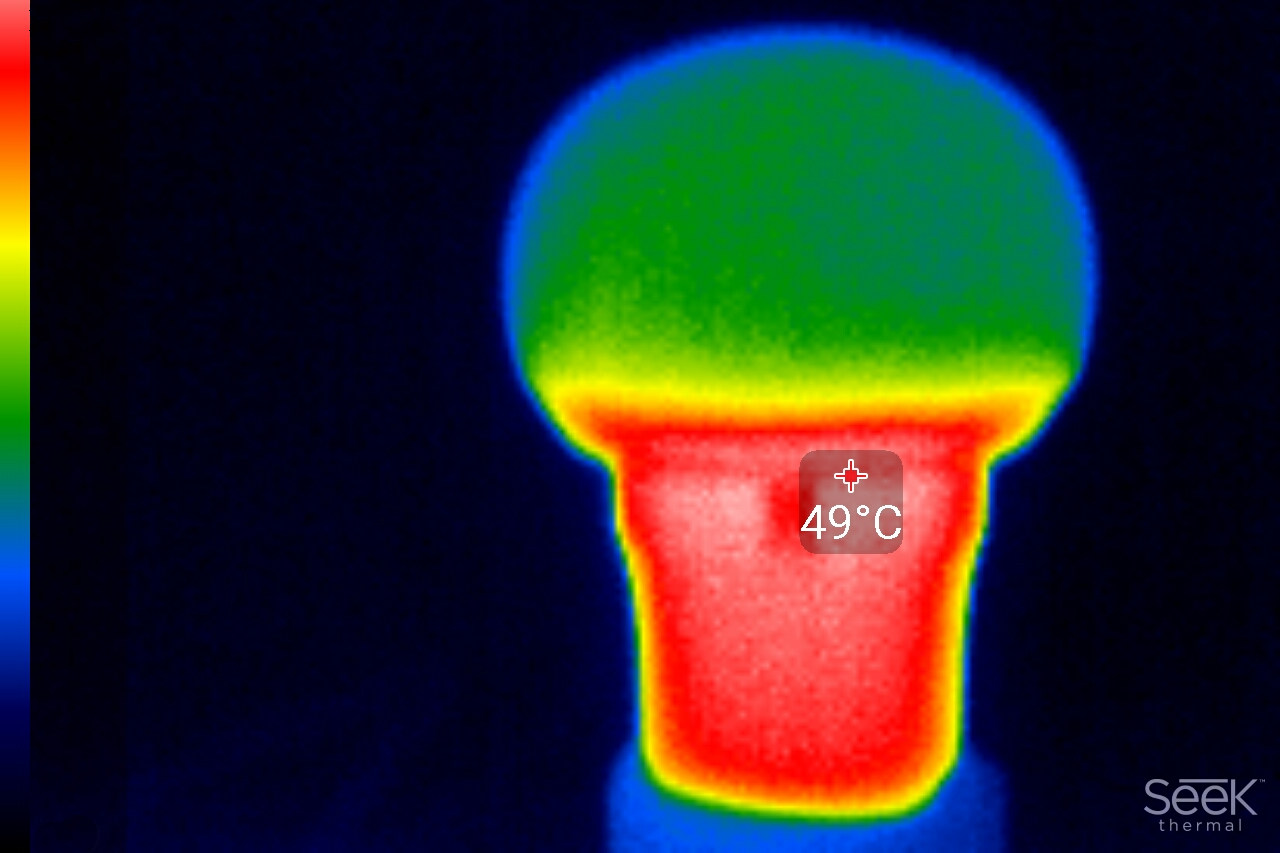
This means that the lamp has a chance to work for quite a long time, even though the site claims a very small lifetime for LED lamps - 8000 hours.
The only question that arises to this lamp is whether it gives enough light and what kind of incandescent lamp can it fully replace. In order to get an accurate answer to this question, I additionally tested two ordinary matt incandescent 60W lamps - OSRAM and Philips.

Using the stabilizer Stab Instab 500 , LATP Suntek TDGC2-0.5 and the accurate multimeter Aneng AN8001, I applied various voltages to the lamps and measured the luminous flux.
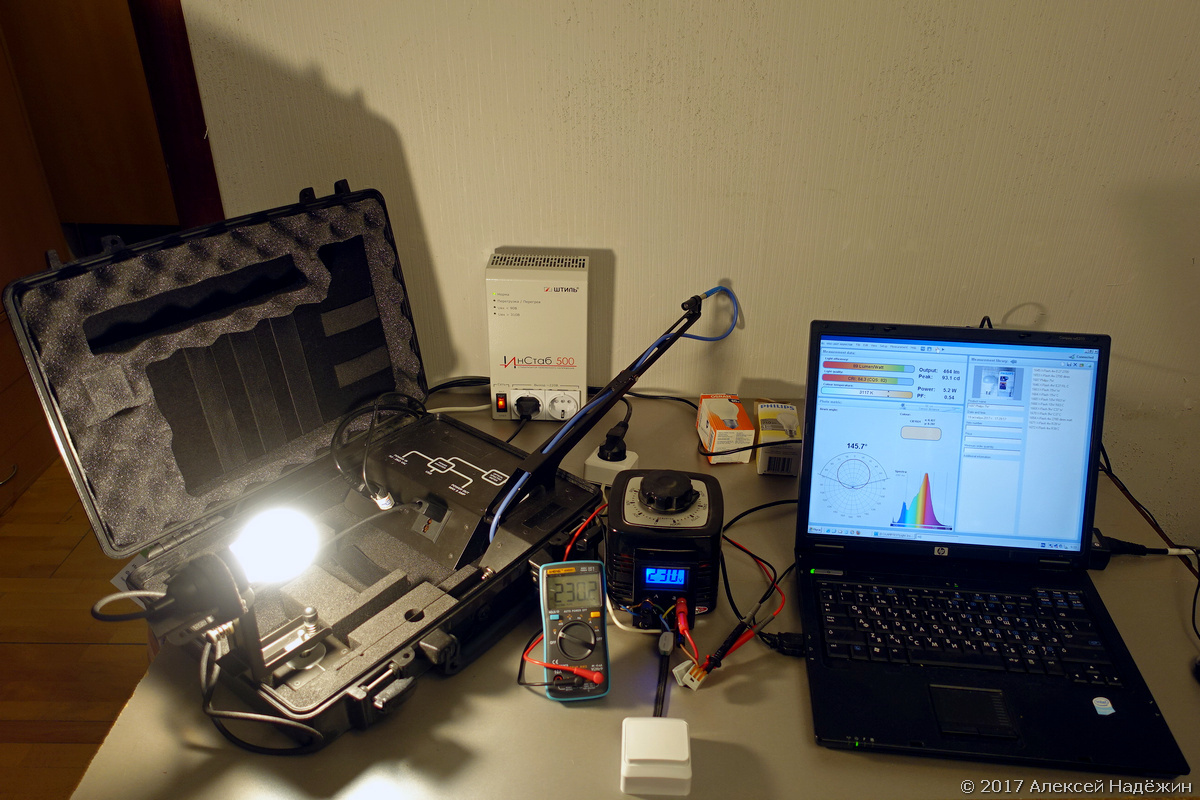
On the packaging of both lamps indicated operating voltage of 230 V and the luminous flux of 710 lm. In fact, they give less light and its amount is very dependent on the voltage of the network.
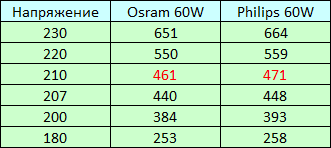
If the mains voltage exactly corresponds to the nominal - 230 volts, the 60-watt incandescent bulbs will be brighter than the LED lamp, giving 464 lm. But not everywhere in the network 230 volts. According to GOST 29322-92, the mains voltage can decrease by 10%, that is, to 207 volts. With this voltage, the LED lamp, which does not change the brightness when the mains voltage decreases, will already be brighter than 60-watt incandescent lamps, and at a voltage of 210 volts their brightness will be approximately equal. In some (usually rural) areas, the voltage in the network sometimes drops to even 180 volts. At such a voltage, 60-watt lamps will shine very dimly - about 250 lm (as much as a 25-watt incandescent lamp gives at a nominal voltage), and the LED lamp will shine as brightly as at a nominal voltage.
It can not but rejoice that cheap and high-quality lamps have finally appeared on the counters of a chain of grocery stores covering the whole country. They may not be the brightest, but unlike the rubbish that was sold before and continues to be sold in other grocery stores, they do not spoil the eyes of customers with a pulsation, do not distort colors with poor color reproduction, and I hope they will last for a long time.
© 2017, Alexey Nadyozhin

I went to the nearest store and bought a lamp with a warm light there.

The manufacturer lists the following parameters on the packaging:
Power: 7 W;
Operating voltage: 220-240 V;
Light stream: 480 lm;
Replaces the incandescent lamp 55 watts.
Service life more than 8 years
Warranty period 2 years.
There is no exact color temperature, color rendering index, or service life on the package.
It is stated that “the lamps fully comply with the declared luminous flux. The minimum level of pulsation. Lamps are completely safe and comfortable for the eyes. "
Check it out.
The luminous flux of the lamp was measured with a Viso Light Spion instrument, the power consumption of a Robiton PM-2 instrument, a color rendering index, color temperature and ripple with a Uprtek MK350D instrument . Before testing, the lamp warmed up for an hour.

The measured luminous flux (464 lm) turned out to be lower than the declared by only 3% - this is within the limits of the measurement error.
Power consumption is even less than the stated - only 5.35 watts. Color temperature about 3100K. This kind of light is whiter than that of incandescent bulbs, but quite comfortable and much "warmer" than the light of 4000K white light bulbs. The pulsation of light is completely absent. The color rendering index is 83.3 and this is good (it is considered that CRI should be more than 80 for residential premises). Surprisingly, on the manufacturer's website for this lamp the color rendition index is declared 70. For the first time I come across the fact that the manufacturer declares the parameters worse than they really are. Perhaps the site is just a typo.
Although the box has a range of operating voltages of 220-240 volts, the lamp operates when the supply voltage drops to 98 volts, while the luminous flux is at least 90% of the nominal.
The packaging indicates (although very small print on the sticker) that the lamp cannot be used with dimmers and switches with indicators.

I checked the operation of the lamp with a switch having an indicator. When the switch is off, the lamp glows weakly and evenly. Most likely it will not damage the lamp in any way and it can be used with such a switch in the night light mode, which consumes almost no energy.
The measurement results of the Viso Light Spion instrument (in the table I give the measurement results with more accurate instruments, so the values of voltage, power, color temperature and color rendering index are slightly different).

This lamp, despite the low price, really gives high-quality, comfortable and safe light.
During operation, the lamp does not heat up much - the maximum body temperature is 49 degrees.

This means that the lamp has a chance to work for quite a long time, even though the site claims a very small lifetime for LED lamps - 8000 hours.
The only question that arises to this lamp is whether it gives enough light and what kind of incandescent lamp can it fully replace. In order to get an accurate answer to this question, I additionally tested two ordinary matt incandescent 60W lamps - OSRAM and Philips.

Using the stabilizer Stab Instab 500 , LATP Suntek TDGC2-0.5 and the accurate multimeter Aneng AN8001, I applied various voltages to the lamps and measured the luminous flux.

On the packaging of both lamps indicated operating voltage of 230 V and the luminous flux of 710 lm. In fact, they give less light and its amount is very dependent on the voltage of the network.

If the mains voltage exactly corresponds to the nominal - 230 volts, the 60-watt incandescent bulbs will be brighter than the LED lamp, giving 464 lm. But not everywhere in the network 230 volts. According to GOST 29322-92, the mains voltage can decrease by 10%, that is, to 207 volts. With this voltage, the LED lamp, which does not change the brightness when the mains voltage decreases, will already be brighter than 60-watt incandescent lamps, and at a voltage of 210 volts their brightness will be approximately equal. In some (usually rural) areas, the voltage in the network sometimes drops to even 180 volts. At such a voltage, 60-watt lamps will shine very dimly - about 250 lm (as much as a 25-watt incandescent lamp gives at a nominal voltage), and the LED lamp will shine as brightly as at a nominal voltage.
It can not but rejoice that cheap and high-quality lamps have finally appeared on the counters of a chain of grocery stores covering the whole country. They may not be the brightest, but unlike the rubbish that was sold before and continues to be sold in other grocery stores, they do not spoil the eyes of customers with a pulsation, do not distort colors with poor color reproduction, and I hope they will last for a long time.
© 2017, Alexey Nadyozhin
All Articles